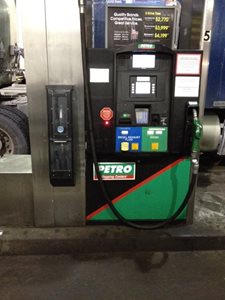
Our 2015 Cascadia has the customary two fuel tanks with the big difference being one tank on the drivers side is 120-gallons and the tank on the passenger side is 80-gallons. Our former truck had three fuel tanks with one tank dedicated to the generator and used off road or reefer fuel.
With the fuel mileage we were anticipating with the truck we decided to eliminate one fuel tank. The 120-gallon tank is used for the engine and the 80-gallon tank is for the ONAN generator.
The weight of fuel is approximately 7lbs and while weight is not usually an issue with the type of freight we haul it still helped to take weight off of the front axle. We have had the truck on the road now for almost two months and we are not regretting this decision.
Our fuel stops are coordinated to when we are switching drivers or before the other goes to bed. On our previous trucks our goal was to fuel when we switched drivers and that was typically around 600 miles. Now though we tend to fuel once a day and our longest fuel up was 1222 miles.
The DD13 has 36702 miles and the average fuel mileage is 12.32. Due to the type of freight we haul our loads are usually very light and the freight is always placed at the back of the freight box. Our empty weight though is heavier then a tractor as we weigh in empty at 31,000 lbs.